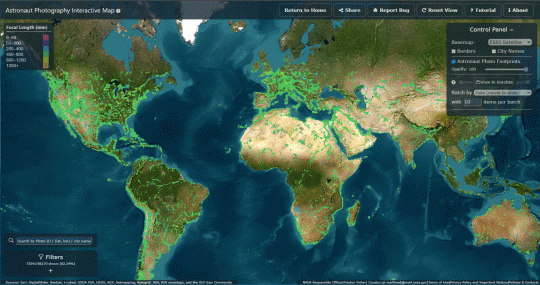ISS048-E-72284
| NASA Photo ID | ISS048-E-72284 |
| Focal Length | 800mm |
| Date taken | 2016.09.03 |
| Time taken | 10:49:02 GMT |
1000 x 666 pixels 540 x 360 pixels 4928 x 3280 pixels 720 x 480 pixels 4928 x 3280 pixels 640 x 426 pixels
Country or Geographic Name: | GREECE |
Features: | SANTORINI, THIRASIA, NEA KAMENI, THERA |
| Features Found Using Machine Learning: | |
Cloud Cover Percentage: | 10 (1-10)% |
Sun Elevation Angle: | 60° |
Sun Azimuth: | 199° |
Camera: | Nikon D4 Electronic Still Camera |
Focal Length: | 800mm |
Camera Tilt: | 23 degrees |
Format: | 4928E: 4928 x 3280 pixel CMOS sensor, 36.0mm x 23.9mm, total pixels: 16.6 million, Nikon FX format |
Film Exposure: | |
| Additional Information | |
| Width | Height | Annotated | Cropped | Purpose | Links |
|---|---|---|---|---|---|
| 1000 pixels | 666 pixels | No | No | Earth From Space collection | Download Image |
| 540 pixels | 360 pixels | Yes | No | Earth From Space collection | Download Image |
| 4928 pixels | 3280 pixels | No | No | NASA's Earth Observatory web site | Download Image |
| 720 pixels | 480 pixels | Yes | No | NASA's Earth Observatory web site | Download Image |
| 4928 pixels | 3280 pixels | No | No | Download Image | |
| 640 pixels | 426 pixels | No | No | Download Image |
The outer islands in this detailed astronaut view are arranged in an oval shape: they are all that remains of a large circular volcano. Taken from the International Space Station, the image shows the largest island is the tourist mecca Santorini (also known as Thira) with an airport on the east side. The other islands making the ring are Thirasia (at image top right) and small Aspronisi (at image top center). This ring marked the what was once a volcanic cone making a single island. Santorini is essentially what remains after an enormous volcanic eruption destroyed most of the island. Water from the Aegean Sea rushed in to fill the void, making the central, 12 km-long (7.5 mi) lagoon.
The lagoon is surrounded by high, steep cliffs on three sides (300 m, 980 ft). Several towns occupy the top of these impressive, near-vertical cliffs, appearing as white stipple from the traditional whitewash paint that is almost exclusively used on these islands. The wake of a boat moving south appears between Thirasia and Aspronisi. Ships arrive at the landing stage at the bottom of the cliffs near the main town of Fira (at image lower center). Tourists then climb the switchback road up the cliffs to the town--the classic Greek village on a cliff face looking out into the great lagoon. Santorini is described as one of the most famous tourist islands on Earth.
The caldera explosion that made this lagoon is one of the largest known, estimated at 100 km3 of material blown away by the explosion. This is four times as much as the well-recorded eruption by Krakatoa in 1883. With this historical significance the date of the explosion has been carefully researched and is now known to have taken place between 1600 and 1627 BCE. Archeological excavations at the town of Akrotiri (at image left) are revealing exciting remains of a Minoan-age town with streets, three-storey houses and frescoes well preserved under ash the layers, much like those preserved at Pompeii.
As an active volcano, the central peak has grown and then erupted repeatedly. The most recent peak of the underwater volcano appeared above water as the island of Nea Kameni in the middle of the lagoon in 1707. This undersea volcano is the current center of volcanic activity. Eruptions continue here with three in the twentieth century alone. Recent lava flows on the island appear as dark-toned areas, compared with the older lighter-toned surfaces of the outer islands. A detailed astronaut image of part of Santorini and Nea Kameni taken in 2008 can be seen here (ISS017-E-5037).
Santorini has been designated a Decade Volcano because it poses more than one volcanic hazard to people living near it. Another Decade Volcano is Sicily's Mount Etna, 400 km to the west of Santorini, whose more frequent eruptions are often photographed by astronauts (ISS005-E-19024).




